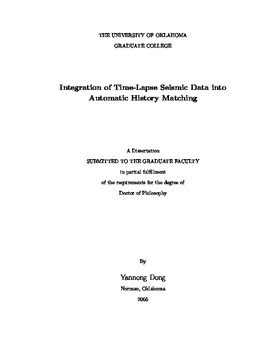| dc.contributor.advisor | Oliver, Dean S., | en_US |
| dc.contributor.author | Dong, Yannong. | en_US |
| dc.date.accessioned | 2013-08-16T12:19:39Z | |
| dc.date.available | 2013-08-16T12:19:39Z | |
| dc.date.issued | 2005 | en_US |
| dc.identifier.uri | https://hdl.handle.net/11244/839 | |
| dc.description.abstract | As an alternate to automating history matching through the minimization approach, the ensemble Kalman filter (EnKF) can be used to rapidly update the estimate of model variables. One advantage of the EnKF method is that it is relatively easy to implement as there is no need to write extensive simulator-dependent code. The EnKF can be used to assimilate observed data as they become available to continuously update a set of reservoir simulation models, which makes the EnKF suitable for high-frequency input, for example, measurements from permanent sensors. Generation of an ensemble of "history-matched" models is very appropriate for conducting uncertainty analysis. In this work, a small synthetic case study is used to show that it is possible to integrate both time-lapse seismic impedance data and production data using the EnKF. | en_US |
| dc.description.abstract | Using the Bayesian framework, the identification of the most probable reservoir model in automatic history matching can be changed into a minimization problem, whose objective function includes square difference between observed data and computed data, as well as square difference between current model parameters and prior model information. Minimizing the objective function once can provide one realization of reservoir field. Due to the non-linearity of the equations describing 3-D, 3-phase flow in porous media, the minimization process is very demanding in both gradient and search direction computations. In this work, the adjoint method (Lagrange Multiplier) is used for gradient computation and the limited memory Broyden-Fletcher-Goldfarb-Shanno (LBFGS) method for search direction calculation. | en_US |
| dc.description.abstract | Production data, such as bottomhole pressure (Pwf), gas oil ratio (GOR), and water oil ratio (WOR), are widely used in automatic history matching. Although they can provide high resolution estimation around well locations, properties in regions far from wells are poorly constrained. To reduce uncertainty in estimation, seismic data can be integrated with the production data, to provide areally dense information across whole field. In this work, seismic P-wave impedance change data derived from time-lapse (4D) seismic are used. A series of rock physics models have been added to the reservoir simulator, C&barbelow; hevron L&barbelow; imited A&barbelow; pplication S&barbelow; imulation S&barbelow; ystem (CLASS), making it possible to compute seismic impedance using saturations and pressures from the simulator. A semi-synthetic case study is used to test the effectiveness of this methodology, and a real case from Bay Marchand field, Gulf of Mexico, shows its potential in an industry level application. | en_US |
| dc.format.extent | xvii, 176 leaves : | en_US |
| dc.subject | Engineering, Petroleum. | en_US |
| dc.subject | Inversion (Geophysics) | en_US |
| dc.subject | Reservoir oil pressure. | en_US |
| dc.subject | Oil reservoir engineering Mathematical models. | en_US |
| dc.title | Integration of time-lapse seismic data into automatic history matching. | en_US |
| dc.type | Thesis | en_US |
| dc.thesis.degree | Ph.D. | en_US |
| dc.thesis.degreeDiscipline | Mewbourne School of Petroleum and Geological Engineering | en_US |
| dc.note | Source: Dissertation Abstracts International, Volume: 66-01, Section: B, page: 0524. | en_US |
| dc.note | Adviser: Dean S. Oliver. | en_US |
| ou.identifier | (UMI)AAI3162833 | en_US |
| ou.group | Mewbourne College of Earth and Energy::Mewbourne School of Petroleum and Geological Engineering | |
